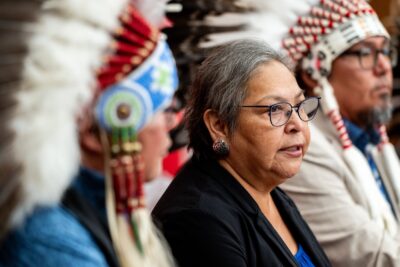Major projects: How Bill C-5 works and why Indigenous leaders are so concerned
By Canadian Press on July 17, 2025.

OTTAWA — Prime Minister Mark Carney held a meeting with hundreds of First Nations chiefs Thursday, amid widespread skepticism and frustration over his controversial major-projects legislation.
Bill C-5 gives the federal government sweeping new powers to speed up permitting for what the Liberals call “nation-building projects.”
Carney says Bill C-5 is needed to shore up the economy in the face of a trade war with the United States, while opponents call it a massive power grab.
Here’s what’s C-5 does and what people are saying about it.
What problem is this trying to solve?
Canada has built few large projects over the past decade. That has led Conservatives, some provinces and some industry groups to argue that Ottawa’s regulatory burdens are holding back growth.
The Liberals tried to streamline project approvals through Bill C-69, an impact assessment law meant to resolve environmental and Indigenous concerns upfront to keep projects from getting tied up in the courts.
Critics say the legislation has actually been holding back major infrastructure projects since it became law in 2019. Federal Conservatives have dubbed the law the “No More Pipelines Act” and it’s deeply unpopular in Alberta and Saskatchewan.
Carney was elected in April with a mandate to diversify Canada’s economy and ensure exports can more easily reach countries beyond the U.S.
Ottawa has also promised to build up northern infrastructure, in part to meet a NATO military alliance spending target for critical infrastructure.
Carney said Bill C-5 “creates the ability to flip … the attitude towards those projects once they are selected, once conditions are put in place — how those projects can move forward, as opposed to why.”
Which projects could be fast-tracked?
We don’t know yet. The government has pointed to ports, railways and sometimes pipelines. The Ontario government has suggested a major commuter highway tunnel could qualify as a nation-building project.
What are the provinces doing?
Some provinces have also passed legislation aimed at speeding up development.
Ontario’s government has given itself the right through Bill 5 to designate “special economic zones” where it can suspend everything from safety rules to environmental and labour standards, with a focus on mining projects.
British Columbia’s Bill 15 similarly allows the province to expedite the construction of anything from critical mineral mines to local hospitals.
What’s in the federal bill?
The legislation has two main parts.
The first part looks to eliminate barriers to interprovincial trade and labour mobility and work to harmonize various regulations across the country. It also allows Ottawa to decide that goods and services that have met one province’s requirements can be deemed to have met “comparable federal requirements” when moving interprovincially.
That might involve things like energy efficiency standards on household appliances.
The main part of the bill relates to fast-tracking approvals for projects that Ottawa decides are “in the national interest.” The government says that decision is meant to be based on five criteria, including whether the project can “strengthen Canada’s autonomy, resilience and security,” help fight climate change or “advance the interests of Indigenous peoples.”
Getting that seal of approval would clear all federal approvals for the project — including virtually all environmental laws — while requiring the proponent to fulfil obligations set out by Ottawa.
Why the rush?
The government fast-tracked Bill C-5 with support from the Conservatives, and the House delivered the bill to the Senate with a programming motion that effectively forced the upper chamber to pass it within days.
Critics called for a deeper review of the bill, arguing there was no need to rush it through because proposed fast-track projects won’t start work before Parliament returns from its summer break.
The government also could have had Parliament sit through the summer, instead of sending MPs and senators home for 12 weeks.
How do Indigenous Peoples feel?
There is widespread opposition to the legislation among First Nations, Inuit and Métis leaders, who argue elements of it could be used to undermine their rights.
The government had amended the legislation to clarify it cannot override the Indian Act, though Indigenous leaders say it still puts fundamental rights at risk. The bill didn’t mention a UN declaration Ottawa has endorsed that promises those communities “free, prior and informed consent.”
The Assembly of First Nations warned that the government’s plan to set up advisory councils after the bill becomes law does not give real power to Indigenous communities on the ground.
Those criticisms were amplified in the hastily organized meeting that took place Thursday. Chiefs have been complaining that they are not getting direct talks with Carney and his ministers, while being barred from allowing technical staff to attend the meeting.
Some walked out of the meeting after realizing much of it consisted of free time for chiefs to discuss the legislation with each other, instead of having direct engagement with the government. Other chiefs boycotted the process.
Chief Phyllis Whitford of O’Chiese First Nation of Alberta said the meetings were “political theatre” and not meaningful consultation.
“This is a pre-determined process — a process that is disrespectful, top-down and (that) divided Indigenous leaders, by privileging some voices over others,” she said.
Chief Vernon Watchmaker of Kehewin Cree Nation, also of Alberta, predicted more court battles leading to less investor confidence, thanks to legislation that centralizes power in Ottawa.
“That is not modernization. It is colonization in 2025,” he said.
Some Indigenous communities have welcomed the legislation, including some Alberta communities with economic stakes in energy projects and the Manitoba Métis Federation. Others say they are ready to undertake widespread, disruptive protests against specific projects.
— With files from Kyle Duggan and Alessia Passafiume
This report by The Canadian Press was first published July 17, 2025.
Dylan Robertson, The Canadian Press
44-43




